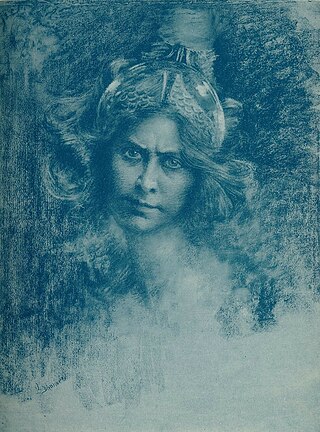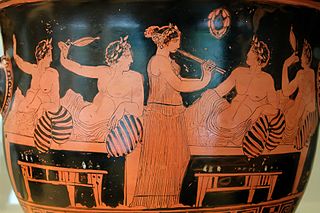
Alcaeus of Mytilene was a lyric poet from the Greek island of Lesbos who is credited with inventing the Alcaic stanza. He was included in the canonical list of nine lyric poets by the scholars of Hellenistic Alexandria. He was a contemporary of Sappho, with whom he may have exchanged poems. He was born into the aristocratic governing class of Mytilene, the main city of Lesbos, where he was involved in political disputes and feuds.

Sappho was an Archaic Greek poet from Eresos or Mytilene on the island of Lesbos. Sappho is known for her lyric poetry, written to be sung while accompanied by music. In ancient times, Sappho was widely regarded as one of the greatest lyric poets and was given names such as the "Tenth Muse" and "The Poetess". Most of Sappho's poetry is now lost, and what is extant has mostly survived in fragmentary form; only the Ode to Aphrodite is certainly complete. As well as lyric poetry, ancient commentators claimed that Sappho wrote elegiac and iambic poetry. Three epigrams formerly attributed to Sappho are extant, but these are actually Hellenistic imitations of Sappho's style.
Ibycus was an Ancient Greek lyric poet, a citizen of Rhegium in Magna Graecia, probably active at Samos during the reign of the tyrant Polycrates and numbered by the scholars of Hellenistic Alexandria in the canonical list of nine lyric poets. He was mainly remembered in antiquity for pederastic verses, but he also composed lyrical narratives on mythological themes in the manner of Stesichorus. His work survives today only as quotations by ancient scholars or recorded on fragments of papyrus recovered from archaeological sites in Egypt, yet his extant verses include what are considered some of the finest examples of Greek poetry.

Anyte of Tegea was a Hellenistic poet from Tegea in Arcadia. Little is known of her life, but twenty-four epigrams attributed to her are preserved in the Greek Anthology, and one is quoted by Julius Pollux; nineteen of these are generally accepted as authentic. She introduced rural themes to the genre, which became a standard theme in Hellenistic epigrams. She is one of the nine outstanding ancient women poets listed by Antipater of Thessalonica in the Palatine Anthology. Her pastoral poetry may have influenced Theocritus, and her works were adapted by several later poets, including Ovid.

Corinna or Korinna was an ancient Greek lyric poet from Tanagra in Boeotia. Although ancient sources portray her as a contemporary of Pindar, not all modern scholars accept the accuracy of this tradition. When she lived has been the subject of much debate since the early twentieth century, proposed dates ranging from the beginning of the fifth century to the late third century BC.

Telesilla was an ancient Greek lyric poet from Argos, active in the fifth century BC. She is known for her supposed role in the defence of Argos in 494 BC, which is doubted by modern scholars. Only a few fragments of her poetry survive, several of which reference the gods Apollo and Artemis. The longest surviving fragment, only two lines, is quoted by the grammarian Hephaestion to illustrate the Telesillan metre, named after her. She was apparently famous in antiquity, included by Antipater of Thessalonica in his canon of women poets; in the twentieth century she inspired a poem by the imagist poet H.D.

Erinna was an ancient Greek poet. She is best known for her long poem The Distaff, a 300-line hexameter lament for her childhood friend Baucis, who had died shortly after her marriage. A large fragment of this poem was discovered in 1928 at Oxyrhynchus in Egypt. Along with The Distaff, three epigrams ascribed to Erinna are known, preserved in the Greek Anthology. Biographical details about Erinna's life are uncertain. She is generally thought to have lived in the first half of the fourth century BC, though some ancient traditions have her as a contemporary of Sappho; Telos is generally considered to be her most likely birthplace, but Tenos, Teos, Rhodes, and Lesbos are all also mentioned by ancient sources as her home.

Anactoria is a woman mentioned in the work of the ancient Greek poet Sappho. Sappho, who wrote in the late seventh and early sixth centuries BCE, names Anactoria as the object of her desire in a poem numbered as fragment 16. Another of her poems, fragment 31, is traditionally called the "Ode to Anactoria", though no name appears in it. As portrayed by Sappho, Anactoria is likely to have been an aristocratic follower of hers, of marriageable age. It is possible that fragment 16 was written in connection with her wedding to an unknown man. The name "Anactoria" has also been argued to have been a pseudonym, perhaps of a woman named Anagora from Miletus, or an archetypal creation of Sappho's imagination.

Nossis was a Hellenistic poet from Epizephyrian Locris in Magna Graecia. Probably well-educated and from a noble family, Nossis was influenced by and claimed to rival Sappho. Eleven or twelve of her epigrams, mostly religious dedications and epitaphs, survive in the Greek Anthology, making her one of the best-preserved ancient Greek women poets, though her work does not seem to have entered the Greek literary canon. In the twentieth century, the imagist poet H. D. was influenced by Nossis, as was Renée Vivien in her French translation of the ancient Greek women poets.

A skolion, also scolion, was a song sung by invited guests at banquets in ancient Greece. Often extolling the virtues of the gods or heroic men, skolia were improvised to suit the occasion and accompanied by a lyre, which was handed about from singer to singer as the time for each scolion came around. "Capping" verses were exchanged, "by varying, punning, riddling, or cleverly modifying" the previous contribution.
Sappho 31 is an archaic Greek lyric poem by the ancient Greek poet Sappho of the island of Lesbos. The poem is also known as phainetai moi after the opening words of its first line. It is one of Sappho's most famous poems, describing her love for a young woman.

Sappho 16 is a fragment of a poem by the archaic Greek lyric poet Sappho. It is from Book I of the Alexandrian edition of Sappho's poetry, and is known from a second-century papyrus discovered at Oxyrhynchus in Egypt at the beginning of the twentieth century. Sappho 16 is a love poem – the genre for which Sappho was best known – which praises the beauty of the narrator's beloved, Anactoria, and expresses the speaker's desire for her now that she is absent. It makes the case that the most beautiful thing in the world is whatever one desires, using Helen of Troy's elopement with Paris as a mythological exemplum to support this argument. The poem is at least 20 lines long, though it is uncertain whether the poem ends at line 20 or continues for another stanza.

Sappho 44 is a fragment of a poem by the archaic Greek poet Sappho, which describes the wedding of Hector and Andromache. Preserved on a piece of papyrus found in Egypt, it is the longest of Sappho's surviving fragments, and is written in epic style suiting its subject. The metre is glyconic with double dactylic expansion.

Myrtis was an ancient Greek poet from Anthedon, a town in Boeotia. She was said to have taught the poets Pindar and Corinna. The only surviving record of her poetry is a paraphrase by the 1st-century AD historian Plutarch, discussing a local Boeotian legend. In antiquity she was included by the 1st-century BC epigrammatist Antipater of Thessalonica in his canon of nine female poets, and a bronze statue of her was reportedly made by Boïscus, a sculptor about whom nothing more is known. In the modern world, Myrtis has been represented in artworks by Judy Chicago and Anselm Kiefer, and a poem by Michael Longley.

The Ode to Aphrodite is a lyric poem by the archaic Greek poet Sappho, who wrote in the late seventh and early sixth centuries BCE, in which the speaker calls on the help of Aphrodite in the pursuit of a beloved. The poem survives in almost complete form, with only two places of uncertainty in the text, preserved through a quotation from Dionysius of Halicarnassus' treatise On Composition and in fragmentary form in a scrap of papyrus discovered at Oxyrhynchus in Egypt.

The midnight poem is a fragment of Greek lyric poetry preserved by Hephaestion. It is possibly by the archaic Greek poet Sappho, and is fragment 168 B in Eva-Maria Voigt's edition of her works. It is also sometimes known as PMG fr. adesp. 976 – that is, fragment 976 from Denys Page's Poetae Melici Graeci, not attributed to any author. The poem, four lines describing a woman alone at night, is one of the best-known surviving pieces of Greek lyric poetry. Long thought to have been composed by Sappho, it is one of the most frequently translated and adapted of the works ascribed to her.

Sappho 94, sometimes known as Sappho's Confession, is a fragment of a poem by the archaic Greek poet Sappho. The poem is written as a conversation between Sappho and a woman who is leaving her, perhaps in order to marry, and describes a series of memories of their time together. It survives on a sixth-century AD scrap of parchment. Scholarship on the poem has focused on whether the initial surviving lines of the poem are spoken by Sappho or the departing woman, and on the interpretation of the eighth stanza, possibly the only mention of homosexual activities in the surviving Sapphic corpus.

Sappho 2 is a fragment of a poem by the archaic Greek lyric poet Sappho. In antiquity it was part of Book I of the Alexandrian edition of Sappho's poetry. Sixteen lines of the poem survive, preserved on a potsherd discovered in Egypt and first published in 1937 by Medea Norsa. It is in the form of a hymn to the goddess Aphrodite, summoning her to appear in a temple in an apple grove. The majority of the poem is made up of an extended description of the sacred grove to which Aphrodite is being summoned.

Sappho was an ancient Greek lyric poet from the island of Lesbos. She wrote around 10,000 lines of poetry, only a small fraction of which survives. Only one poem is known to be complete; in some cases as little as a single word survives. Modern editions of Sappho's poetry are the product of centuries of scholarship, first compiling quotations from surviving ancient works, and from the late 19th century rediscovering her works preserved on fragments of ancient papyri and parchment. Along with the poems which can be attributed with confidence to Sappho, a small number of surviving fragments in her Aeolic dialect may be by either her or her contemporary Alcaeus. Modern editions of Sappho also collect ancient "testimonia" which discuss Sappho's life and works.

Sappho 96 is a poem by the archaic Greek lyric poet Sappho. 37 lines of the fragment are preserved on a 6th-century parchment. The first twenty lines describe an imaginary scene in which an unnamed woman is struck by grief remembering an absent companion, Atthis; the remaining 17 lines, possibly originally a separate poem, reflects more generally on the foolishness of trying to compare human and divine beauty. As with other poems by Sappho such as poem 16 and 94, memory is a major theme.

















